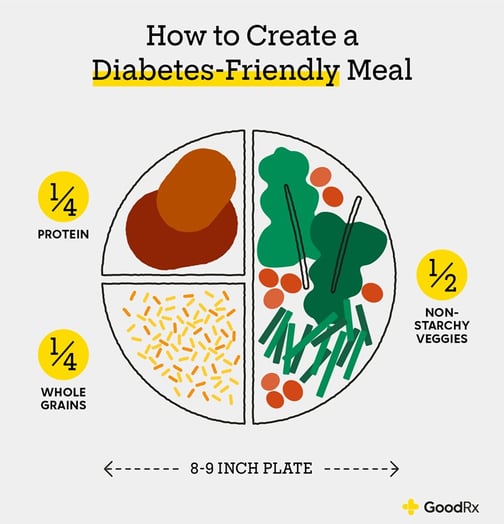‘If you don’t take action now, it could lead to Diabetes.’
That’s the text message I received from my doctor’s surgery after a routine blood test. I was horrified to learn that I was Prediabetic - a condition where my blood sugar levels were too high. It is a growing global problem with around 1 in 14 people living with diabetes (Source: Diabetes UK).
Prediabetes is a serious health condition where blood sugar levels are higher than normal, but not yet high enough yet to be diagnosed as type 2 diabetes. It is reversible with diet and lifestyle changes, however, progression to Diabetes carries serious health risks.
I immediately decided ‘This will not be me; I will not allow myself to become Diabetic’. Just like that. It’s incredible what we can achieve when faced with extreme events.
I swapped blood-sugar-hiking foods such as white bread, pasta and junk food for those harder-to-find ingredients including quinoa, sourdough bread, and low-fat alternatives.
Most importantly, I decided to learn everything I could about how to reverse this condition and would like to share with you what I’ve learned.
Diabetes In The UK
Many people might picture injections when they think of diabetes. However, that is usually only necessary if you are diagnosed with type 1. A larger number of people may have, or be at risk of, type 2 diabetes.
- 90% of those diagnosed have type 2 diabetes, 8% have type 1.
- At least 2.4 million people may be at risk of developing type 2 diabetes.
- The NHS spends at least £10 billion a year on Diabetes which is roughly 10% of its entire budget.
- It is estimated that 850,000 people have type 2 diabetes without a formal diagnosis.
Source: Diabetes UK.
While exercise can be a large factor in your likelihood of developing diabetes, you may also want to pay attention to the food you consume and the glycaemic index.
What Is The Glycaemic Index?
Sugars and starches can both affect the level of your blood glucose. While low GI foods may allow it to rise and fall over longer periods of time, those with a high index can lead to sharp spikes and drops.
Some lower GI foods that could benefit you, and reduce your likelihood of developing diabetes, can include:
- Multigrain bread
- New potatoes in their skins
- Brown rice
- Bran-based cereals
- Couscous and quinoa
It is important to note that not all low-GI foods may be healthy, and not all high-GI foods should be avoided. Figuring out the right nutrients for your body can allow you to retain some of the things you love.

The Health Benefits Of Remote Work
According to the Office for National Statistics, up to 40% of us are working from home; is that a benefit or disadvantage to our health though?
On the one hand, the temptation of snacks could be harder to resist at home vs the benefits of walking to, from, and around the office, increasing those daily steps naturally through large-open office spaces.
Surprisingly, however, a study by the International Workplace Group found that hybrid workers got an extra 90 minutes each week for exercise and an additional 71 hours of sleep every year.
So regardless of whether you work from home or the office, how can we establish good habits?
5 Practical Tips For Healthy Nutrition Habits At Work
Alison Clark, Registered Dietician, helps companies all over the UK keep employees as healthy as they can be and shares her top tips for adopting good eating habits throughout your day.
- Have a glass or bottle of water by your bed for a ‘first hydration opportunity’ – setting you up for the day and trying to establish new, healthy habits. Plus, you can hydrate before you caffeinate! Have a drink of water before you reach for your morning cuppa or coffee.
- Keep unhealthier foods in tinfoil (so you can’t see them) and at the back of the fridge and not in eye line – keep healthy food at the front of the fridge, so you easily see it when opening the fridge and you won’t be tempted with the unhealthy food.
- If you have to keep unhealthy food in the house – keep it somewhere you have to make an effort to get it. I keep mine in a cupboard in the utility room, right at the back – so I have to REALLY want that snack to make the effort to go and get it!
- Step away from your workstation to eat your meals and snacks and savour and taste them! Take note of what you are eating, the taste and texture etc, rather than eating whilst answering emails or report writing.
- Don’t eat lunch at your desk, as Alison explained to BBC News.
 Is eating lunch at your desk bad for you? - BBC News
Is eating lunch at your desk bad for you? - BBC News
Time For A Check Up?
Thankfully for me, it’s a great news story, I have successfully reduced my blood sugar level through 10 weeks of a strict diet and increased exercise. So much so that I am no longer classed as Prediabetic. We really are what we eat!
Sadly, Prediabetes is on the rise and for many people (myself included) it is only picked up when visiting the doctor for other reasons, as very often there are no symptoms.
It’s been an incredible learning experience, one where employers can play a role too because establishing healthy eating habits ensures we are happy and productive.
Don’t forget to request a blood test if you are also concerned about your risk of developing Diabetes.

